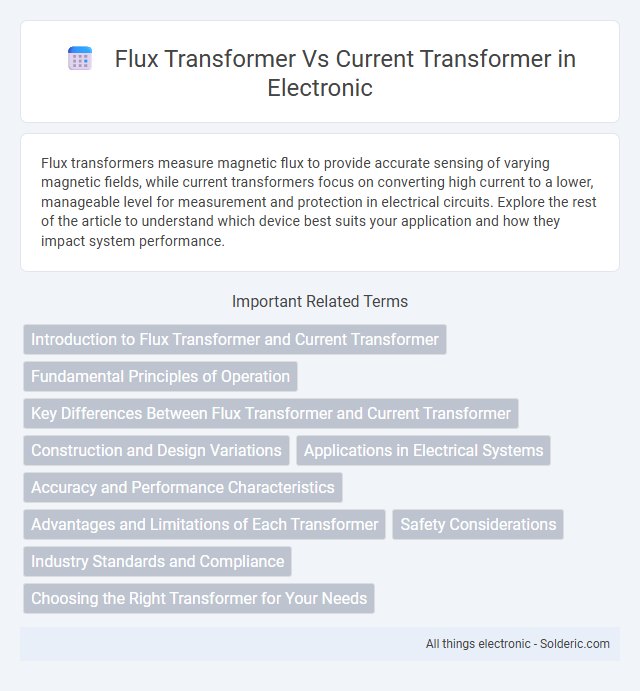Flux transformers measure magnetic flux to provide accurate sensing of varying magnetic fields, while current transformers focus on converting high current to a lower, manageable level for measurement and protection in electrical circuits. Explore the rest of the article to understand which device best suits your application and how they impact system performance.
Comparison Table
| Feature | Flux Transformer | Current Transformer |
|---|---|---|
| Primary Function | Measures magnetic flux | Measures alternating current (AC) |
| Operating Principle | Uses magnetic flux to induce voltage | Induces secondary current proportional to primary current |
| Typical Application | Magnetic field sensing, flux measurements | Electrical current measurement, protection relays |
| Output | Voltage proportional to magnetic flux | Current proportional to primary current |
| Frequency Range | Low to medium frequencies | Wide frequency range, mainly AC |
| Installation | Typically integrated in magnetic circuits | Encircles conductor, external installation |
| Accuracy | Sensitive to magnetic flux changes | High accuracy for current measurement |
| Output Type | Voltage signal | Current signal |
Introduction to Flux Transformer and Current Transformer
Flux transformers and current transformers are essential components in electrical measurement and protection systems, each serving distinct roles. A flux transformer operates by converting magnetic flux into a proportional electrical signal, primarily used in precise flux measurement applications. Your choice between the two depends on whether you need to measure magnetic flux directly with a flux transformer or monitor current flow through a conductor using a current transformer.
Fundamental Principles of Operation
A flux transformer operates by detecting changes in magnetic flux to induce a proportional voltage, making it ideal for measuring varying magnetic fields. A current transformer, on the other hand, works by producing a secondary current proportional to the primary current flowing through its conductor, primarily used for current measurement and protection in AC circuits. Understanding these fundamental principles of operation helps you select the appropriate transformer type for precise electrical measurements and monitoring.
Key Differences Between Flux Transformer and Current Transformer
Flux transformers measure magnetic flux directly, while current transformers sense electrical current by inducing proportional secondary current. Unlike current transformers, flux transformers are primarily used for precise flux detection in magnetic cores, enabling accurate monitoring of magnetic properties. Your choice depends on whether you require direct flux measurement or current scaling for electrical equipment protection and metering.
Construction and Design Variations
Flux transformers and current transformers differ significantly in construction and design; flux transformers use a magnetic core with multiple windings designed to measure flux changes, while current transformers typically feature a single-turn primary winding and a multi-turn secondary winding for current measurement. Flux transformers often include air gaps or special core materials to enhance magnetic sensitivity, whereas current transformers prioritize insulation and thermal stability to handle high current loads safely. Your choice between these devices depends on the specific measurement needs and environmental conditions related to their construction and design variations.
Applications in Electrical Systems
Flux transformers are primarily used for precise measurement of magnetic flux in applications like electromagnetic research and material testing, while current transformers are essential in electrical power systems for measuring alternating current and providing inputs to protective relays and metering devices. Your choice between these devices depends on the specific application: flux transformers excel in sensing magnetic properties, whereas current transformers are vital for accurate current monitoring and ensuring electrical system safety and efficiency. Both play crucial roles in maintaining system performance but serve distinct functions based on their measurement capabilities.
Accuracy and Performance Characteristics
Flux transformers provide higher accuracy in detecting low-frequency and DC currents due to their magnetic core design, minimizing phase shift and signal distortion. Current transformers excel in handling high-frequency AC currents with robust performance, but may introduce errors from core saturation and phase displacement. Selecting between flux transformers and current transformers depends on the specific application requirements for precision, frequency range, and electromagnetic interference resistance.
Advantages and Limitations of Each Transformer
Flux transformers offer high accuracy and low power loss by directly measuring magnetic flux, making them ideal for precise industrial applications; however, they can be more complex and expensive compared to current transformers. Current transformers provide reliable and cost-effective current measurement with robust construction suitable for high-voltage environments, but they have limitations in frequency response and accuracy at low currents. Selecting between flux and current transformers depends on the specific requirements of measurement precision, environmental conditions, and budget constraints.
Safety Considerations
Flux transformers provide enhanced safety by isolating secondary circuits from high voltage, reducing the risk of electric shock during measurements, unlike current transformers where direct connections can pose hazards if secondary circuits open while under load. Current transformers require careful handling and secure secondary circuit closure to prevent dangerous high voltage buildup that can lead to equipment damage or operator injury. Proper insulation and adherence to safety standards are critical for both transformers, but flux transformers inherently offer better protection against secondary voltage faults.
Industry Standards and Compliance
Flux transformers comply with IEC 61869-2, ensuring accuracy and safety in low-power applications, while current transformers follow stringent IEC 60044-1 standards for high-voltage power systems. Both devices meet IEEE and ANSI regulations, maintaining reliability and interoperability across global electrical grids. Industry adherence ensures precise measurement, reducing risks of failures and enhancing system protection in energy distribution networks.
Choosing the Right Transformer for Your Needs
Choosing the right transformer depends on the specific application requirements, where flux transformers excel in measuring magnetic flux with high accuracy, making them ideal for precision instrumentation. Current transformers are preferred for monitoring high current flows safely in power systems by stepping down current levels to manageable values for meters and protective devices. Evaluating factors such as frequency range, load capacity, accuracy class, and environmental conditions ensures optimal performance and reliability for your electrical system.
flux transformer vs current transformer Infographic

 solderic.com
solderic.com